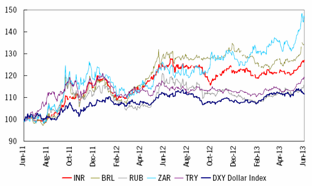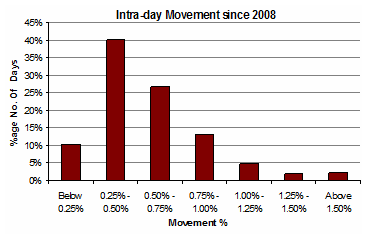The rupee remained under pressure for much of the week with a slide to 11-month lows beyond 57 against the US currency before finding some relief. However, yesterday (10th June 2013) Rupee once came under severe pressure and touched an ALL TIME LOW of 58.1550.
For the previous week, the rupee depreciated 0.90% and traded in the range of 56.30-57.12 levels. The rupee has been falling sharply since the start of May on concerns about the U.S. Federal Reserve withdrawing its monetary stimulus and the likelihood of Reserve Bank of India not cutting rates as much as previously anticipated. The local currency has been falling for five straight weeks, to make it among the worst performing currencies in Asia during this eriod. Bearish bets on the rupee also increased to their largest since late June 2012 as continuing worries about the country's current account deficit weighed on sentiment and as the unit came under pressure from importers' dollar demand.
RBI Governor Duvvuri Subbarao warned on Friday that a high current account gap could feed into a weakening rupee and calibrating the monetary policy in such an environment was a challenge. The Central bank chief was commenting on the rupee depreciation and saidthat RBI intervened in the market only to control volatility. Foreign banks were seen adding long dollar positions based on their non-deliverable forward-related positions. There was also continued dollar buying from oil refiners, the largest buyers of dollars in the domestic currency market. Forward premia went lower. Annualised forward premia for 1month, 3month and 6month ended at 6.35%, 6.06% and 5.77% respectively. 
INR has depreciated 6.07% since the beginning of this year. However, apart from the Rupee’s weakness it is largely a dollar-strength and emerging currencies weakening story. As discussed below, emerging currencies including India benefited the most from US QE program. Now that Fed Chairman Ben S. Bernanke has signaled the central bank could start pulling back if it sees sustained economic improvement, investors are backing away from developing nations, especially those with higher deficits and weaker growth. Speculation the Fed will pull back QE is pushing up yields on U.S. Treasuries, reducing the advantage of emerging-market securities and demand for the currencies needed to buy them.Last month’s slump has wiped out almost half of the gains for emerging-market currencies since 2009, after U.S. policy makers introduced quantitative easing in response to the worst financial crisis since the Great Depression. China’s slowing economy is also weighing on developing-nation currencies. 
INDIAN STOCK MARKET
Markets ended the week on a negative note with benchmark indices falling nearly two-per cent amid looming fear that the falling local currency may further lead to overseas investors paring positions in Indian equities. So far in June, FIIs have net bought shares to the tune of roughly Rs 118crore after, pouring in a little over Rs 83,300 crore. The 30-share Sensex ended down 90 points at 19,429 while the 50-share Nifty ended down 40 points at 5,881 after touching an intra-day low of 5,871. For the week, Sensex shed 331 points or 1.7% to 19,429.23.
FED’S QUANTITATIVE EASING – IMPACT ON INDIA
Late last month, on the back of slightly better data in the US, the Fed hinted that it could slow down its pace of monetary expansion. Ever since there has been a lot of talk going on about earlier than expected Fed tapering off its QE program. As seen in the last few years, easy global monetary policy has worked both ways for India. Initial rounds of quantitative easing resultedin a rise in asset prices including commodities. This took a toll on domestic inflation. Moreover, the global slowdown took a toll on xports while the import bill ballooned as India imports 80% of its crude oil requirements. Adding to the woes was the urge in imports of gold. However, on the positive side, capital flows (equity and debt) got a major boost due to better yields.
Additionally, more and more Indian companies were seen taking overseas loans due to lower global interest rates and easier external commercial borrowing norms. Hence despite a record CAD of US$95bn capital flows have been by and large sufficient to finance the CAD. Currently we're in a situation where the impact of continued expansionary monetary policy on commodities is getting compressed. But as the hunt for yield continues, capital flows continue to remain buoyant. While this does not change things fundamentally but it surely benefits India which is a commodity importer. However, going forward, Fed tapering could result in a re-pricing of risk. This in turn could impact the flows to India given its elevated deficits, continued macro imbalances of sub-par growth and relatively high inflation. This would surely impact equities, bonds and Rupee. Moreover, the recent debt market outflows are already a cause of concern.
CURRENT ACCOUNT DEFICIT REMAINS A CHALLENGE
As discussed above, the drop in commodity prices bodes well for the current account deficit as crude oil/gold account for 44% of imports. However, despite lower commodity prices, only a modest reduction in the CAD is expected. The factors to impact CAD are –
- Productivity issues slowing a revival in exports
- Price-elastic gold imports
- Investment income outflows primarily on account of rising interest payments on external debt.
- Rising coal imports and lower iron-ore exports
In FY13 India’s gold imports stood at US$ 54bn. In an attempt to slowdown the imports of gold, RBI has announced a slew measures in past two months –
MEASURES
MAY
- RBI allows banks to import gold only on a consignment basis
- RBI bans Banks and NBFCs from lending against gold ETFs and MFs
- Banks asked to slowdown sales of gold coins
JUNE
- All nominated agencies/ premier / star trading houses only allowed to import gold to "meet genuine needsof exporters of gold jewellery"
- All letters of credit opened y banks and gold import agencies will be "onlyon 100% margin basis"
- Import duty on gold raised to 8% from 6%
However, the above measures are expected to have a limited impact. The latest data by world Gold Council shows that while the worldwide demand for gold contracted by 13% YoY in 1Q2013, that of India was up 27% YoY. Since thedemand for gold in India is price elastic hence a drop in prices may lead to an increase in its demand.

BEHAVIOUR OF INDIAN RUPEE IN VOLTILE TIMES
There is no doubt that Indian Rupee its on its way to make new record lows but surely its not the first time that Indian Forex market is witnessing such acute volatility. istorical data suggests that there have been times when intra-day movement has been as high as 2%. The following graph highlights the intra-day movement of Rupee for various %range since 2008 in percentage number of days terms. It can be easily seen that 40% of the times Rupee’s intra-day movement has been in the range of 0.25%-0.50%. While its movement above 1.50% has been only in 2% of the total period. Infact the movement above 1% has been only 9% of the period since 2008. However, history also tells us that the rate of depreciation of Rupee has been mostly much steeper than that of appreciation. The reversals of depreciations usually have not been to the same extent. But the reversal of depreciating trend does not take too long to establish itself. In other words even though the pace of depreciation is higher but any given phase of depreciation usually does not last too long at a stretch.

OUTLOOK :
Fundamental
Expectations surrounding the Federal Reserve stance and global growth trends will continue to be extremely important. High volatility is likely to remain an important feature. In India, fresh investments by FII have been outweighed by the outflows. The Forex reserves of the country have also fallen by $4 billion in the week ended 31st may 2013 which has taken the reserves down to $ 288 billion. India’s 4QFY13 GDP came in at 4.8%. Headline PMI dropped 0.9pts to 50.1 in May which is not a good sign. The main concern was output trends which contracted for the first time since Mar 09. The poor trends in PMI indicate that the growth outlook remains far from satisfactory. The growth in the coming quarters is likely to be subdued due to global slowdown and delays in policy action. The market shifts its focus to 17th June when the RBI unveils its credit policy as to whether it will cut rates in view of the falling inflation to support growth or the RBI will keep its hawkish stance till inflation is rought fully under control. Before that there is the IIP data on the 12th and the WPI inflation on the 14th. Turbulence in financial markets could further impact business confidence – already at record lows. This in turn could result in a prolonged period of sub-par growth and further exacerbate the RBI's dilemma on rates. Moreover, the fears of ratings downgrade is still looming large on India and RBI needs to come up with some policy action before it gets too late. On the positive side both WPI and CPI are expected to head lower and this may lead RBI to cut rates by another 50bps in FY14 defying all market speculations. The monsoons have been good so far and should give some relief to the price situation. Keeping the domestic and global perspective in mind, the situation looks grave for the Indian Rupee.
Technical
On weekly chart Rupee is now trading in uncharted territory, after it breached its all time low at 57.3250. The rupee appears to be heading lower to 59.00 – 60.00 levels if no major intervention is witnessed through the week. On the brighter note, any dose of positive news may help Rupee in recovering till 57.32/56.97 levels where it will find very stiff resistance.